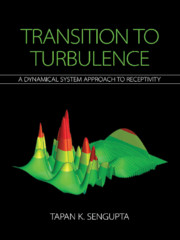Book contents
- Frontmatter
- Dedication
- Contents
- Preface
- 1 Receptivity, Instability, and Transition: A Perspective
- 2 Dynamical System Theory and Role of Equilibrium Flows
- 3 Fundamentals of Scientific Computing
- 4 Instability and Transition
- 5 Receptivity Analysis: Relation with Instability Experiments
- 6 Dynamical System Theory of Linear Receptivity
- 7 Nonlinear, Nonparallel Effects on Receptivity, Instability, and Transition
- 8 Three-Dimensional Routes of Transition to Turbulence
- 9 Receptivity to Free Stream Excitation: Theory, Computations, and Experiments
- 10 Nonlinear Receptivity Theories: Hopf Bifurcations and Proper Orthogonal Decomposition for Instability Studies
- 11 Mixed Convection Flow
- 12 Baroclinic Instability: Rayleigh–Taylor Instability
- 13 Coherent Structure Tracking in Transitional and Turbulent Flows
- 14 The Route of Transition to Turbulence: Solution of Global Nonlinear Navier–Stokes Equation
- References
3 - Fundamentals of Scientific Computing
Published online by Cambridge University Press: 16 February 2021
- Frontmatter
- Dedication
- Contents
- Preface
- 1 Receptivity, Instability, and Transition: A Perspective
- 2 Dynamical System Theory and Role of Equilibrium Flows
- 3 Fundamentals of Scientific Computing
- 4 Instability and Transition
- 5 Receptivity Analysis: Relation with Instability Experiments
- 6 Dynamical System Theory of Linear Receptivity
- 7 Nonlinear, Nonparallel Effects on Receptivity, Instability, and Transition
- 8 Three-Dimensional Routes of Transition to Turbulence
- 9 Receptivity to Free Stream Excitation: Theory, Computations, and Experiments
- 10 Nonlinear Receptivity Theories: Hopf Bifurcations and Proper Orthogonal Decomposition for Instability Studies
- 11 Mixed Convection Flow
- 12 Baroclinic Instability: Rayleigh–Taylor Instability
- 13 Coherent Structure Tracking in Transitional and Turbulent Flows
- 14 The Route of Transition to Turbulence: Solution of Global Nonlinear Navier–Stokes Equation
- References
Summary
Computing Space–Time Dependent Flows
It has been highlighted that the equilibrium flow described in the previous chapter requires high accuracy computations so that the subsequent investigation of receptivity and instability is not affected by numerical artifacts. It is imperative that all spatial and temporal scales are resolved accurately. For example, for the same equilibrium flow, if the imposed excitation level is increased, one may observe different types of transition with different wavenumbers and frequency spectra in the disturbance field. Thus, the behaviors perceived for different perturbed flows are not due to difference in the governing principles – rather these are due to altered boundary and initial conditions. These auxiliary conditions, in general, are given as either Dirichlet or Neumann boundary conditions. In convective heat transfer, one may have to deal with Robin or mixed boundary conditions. There are multiple aspects in computing governing equations for transitional and turbulent flows accurately. For example, one has to resolve all the space–time scales. Specifically, in numerically treating the space–time dependence of the problem, the discretization or integration process must be handled simultaneously. This last aspect is often overlooked, and spatial and temporal discretizations are treated separately. In Chapter 1, we have noted that in studies of instability and receptivity, the dispersion relation plays a central role. A poorly constructed numerical method will not follow this relation; in certain cases, the choice of numerical parameters are such that one incurs large dispersion errors. This aspect has to be studied carefully before one initiates numerical activity in studying instability and transition, which has been highlighted also in [412, 413].
Speaking about spectra and resolution of space and time variation of variables, one would require a good understanding of waves. Although waves were introduced in the context of hyperbolic partial differential equations [540], dispersive waves are present for any flows governed by other types of partial differential equations too [412, 553]. We have noted in Chapter 1, that waves are created during the Kelvin– Helmholtz instability, for which the equilibrium flow is given by a uniform velocity profile and the disturbance field is governed by the Laplace equation (elliptic partial differential equation). In developing high accuracy computing methods in [413], it has been noted that numerical treatment of parabolic and elliptic partial differential equations requires that the discrete equations have the same formalism used for hyperbolic partial differential equations.
- Type
- Chapter
- Information
- Transition to TurbulenceA Dynamical System Approach to Receptivity, pp. 62 - 113Publisher: Cambridge University PressPrint publication year: 2021



